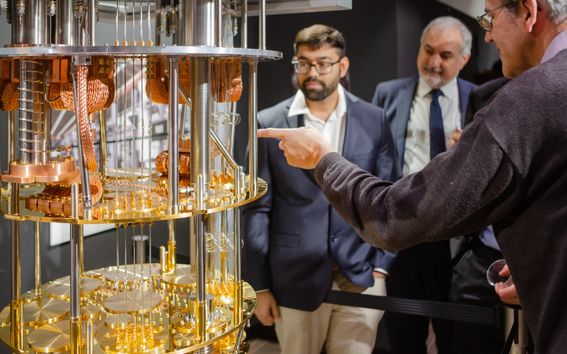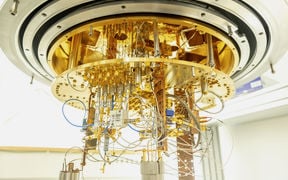InstituteQ - The Finnish Quantum Institute (external link)
InstituteQ coordinates quantum research, education, and business in Finland

In the early-to-mid 1900s, physicists were just beginning to understand how to manipulate and control individual quantum objects and materials. These initial efforts led to the birth of information processing technologies that have brought about the digital age.
We are now in the second quantum revolution, which is characterised by the creation of devices capable of manipulating and controlling individual quantum states, as well as the algorithms and software that exploit the possibilities arising from these capabilities. These developments are expected to outperform classical computing, communication, and sensing technologies in the near future.
These advancements are accomplished through the exploitation of quantum phenomena like the superconductivity of certain materials or the ability of qubits (quantum bits) to be in a superposition of two states. Such phenomena are anticipated to enable enhanced information cryptography, high-precision sensing, new drug development, and high-performance computing, among a host of other outcomes.
And the number of operational early-stage quantum computers in the world is growing. Two of them reside in Finland as part of the collaborative partnership of VTT Technical Research Centre of Finland and IQM. The first, 5-qubit quantum computer was unveiled in 2021, followed by a 20-qubit computer in October 2023.
But there is more to the second quantum revolution than computers…
While revolutionary supercomputers may be the first thing that comes to mind when thinking about quantum technologies, Finland’s rich history in the field spans decades and covers many other subject areas.
For example, Finland first earned its notoriety in quantum technologies via its low-temperature physics research, pioneered by Olli V. Lounasmaa in the 1960s. Sixty years later, the Finnish cryogenics tech company Bluefors is the world’s leading manufacturer of ultra-low temperature refrigerators used in quantum research and technology development.
Additionally, Aalto University researchers are at the vanguard of superconductivity research. One consortium, dubbed SuperC 2033 and led by physics professor Päivi Törmä, aims to realise a room-temperature superconductor by the year 2033. Such a discovery is considered by many to be the holy grail of modern-day physics and carries the capacity to revolutionise the ICT sector—an industry reliant on energy-intensive semiconductors.
And Finnish researchers aren’t afraid to delve into some of the deepest mysteries of quantum physics. Aalto Professor Mika A. Sillanpää leads his research group to prove the existence of quantum gravity, which would effectively demonstrate that gravity has quantum properties and would open doors for a new unified theory. And Aalto Senior Lecturer and Docent Sorin Paraoanu has just received a €2 million grant for his role in the global DarkQuantum consortium, which seeks to prove the existence of dark matter by utilising ultrasensitive quantum detectors.
This list just barely scratches the surface of Finnish quantum physicists’ accolades, and their efforts are only made possible with a skilled and educated workforce…
While this problem is not unique to Finland, its effects can be felt locally. Progress in the field is hindered by the shortage of a skilled and educated workforce. The Finnish Quantum Flagship (FQF) has identified this problem as one of its key focus areas along its eight-year timeline.
One of the primary solutions is the recruitment of top international talent. Academicians and industry leaders alike continue to pressure the Finnish government to revise its immigration policies to make the country more attractive to potential workers. Such sentiments were expressed clearly by Aalto University President Ilkka Niemelä in September 2023.
While their impact may not yet be fully understood, emerging quantum technologies promise to open doors to an untold number of real-world applications. Accordingly, industries, governments, and research institutions must take a broad approach when considering the training of a future workforce. Beyond quantum physicists, the industry will demand engineers, programmers, product designers, and many more experts of varying areas of specialisation.
As global quantum technology powerhouses compete to develop the first computers capable of quantum supremacy, the science that has led to such tantalising possibilities first emerged as subjects of fundamental research.
While applied research in fruitful fields is necessary to move the industry’s proverbial needle forward, foundations and other funding agencies must remain diligent in their investments in fundamental research. These types of investments in basic research have proven to evolve into applied research with real world applications in the past.
The previously mentioned Bluefors case study is just one example of how the labours of previous generations have blossomed into valuable assets for the greater Finnish technological economy. Fostering an environment that sponsors basic research is necessary for the growth of new applications and startups, and it serves as a powerful tool to attract that necessary international talent.
As of 2022, Finland employed over 1 000 personnel in the quantum science and technology sector across Finnish research institutions, universities, and industries. The number of employees working in quantum technology companies was twice the amount of workers in the same field in Denmark, and 20-times higher than in Sweden.
And Finnish researchers of the field have obtained about 10% of all European Research Council grants in Finland, even though the estimated volume of the area corresponds to only about 2-3% of the whole research funding of universities and research institutes. This funding represents a share five-times greater than would be expected when compared to the research volume.
The Finnish government has doubled down on recent quantum technology investments. Its 2024-2027 budget has €79 million allocated to VTT for the development of the Kvanttinova facility in Otaniemi, which will serve as a pilot-line for microelectronics and quantum technology processes. This does not include the additional €70 million also appropriated to VTT for the scaling up of a 300-qubit quantum computer.
Additionally, the Research Council of Finland has just awarded €13 million for the first five years of the eight-year FQF project, which has a special focus on sponsoring collaboration and initiating new business and research ventures between Finnish universities and other research institutions and industrial partners.
Whereas some countries may see competition between the various players in its respective quantum technology arena, Finland has a demonstrated history of collaboration—albeit with a healthy dose of friendly competition as well.
Finnish Research Council invests €13M in quantum tech flagship. Further funding anticipated from host organisations.

Read more about Aalto University's involvement in quantum technology research and development.

InstituteQ coordinates quantum research, education, and business in Finland

The national Quantum Technology Finland (QTF) Centre of Excellence brings together scientific and technological excellence and cutting-edge research infrastructures to harness quantum phenomena in solid-state-based quantum devices and applications.

The flagship unites dozens of research institutions, companies, and startups in new collaborative front



